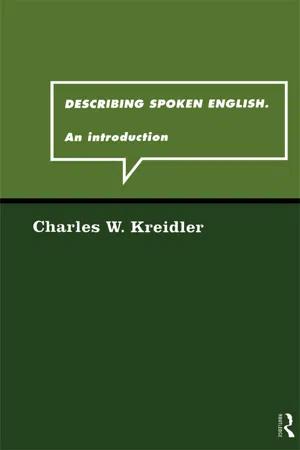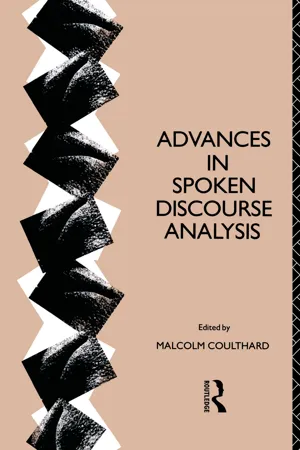Languages & Linguistics
Tone Shift
Tone shift refers to a change in the emotional or expressive quality of language within a piece of writing or speech. It can involve a shift from a serious tone to a humorous one, or from a formal tone to an informal one. Tone shifts can impact the overall mood and meaning of the communication, and are important to consider in linguistic analysis.
Written by Perlego with AI-assistance
4 Key excerpts on "Tone Shift"
- eBook - ePub
- Kirsten Malmkjaer, Kirsten Malmkjaer(Authors)
- 2009(Publication Date)
- Routledge(Publisher)
The evidence is quite strong, therefore, considered both from the viewpoint of internal phonological organisation and from laboratory experimentation, that tones behave much like consonants and vowels in their contribution to building words. Through the chance of historical development, we find today that some languages make use of tones while other languages do not. But the pattern is a changing one, since historical development makes it possible for a tone language to lose its tones, and for a non-tone language to become one.W. S.-Y. W.Suggestions for further reading
Fromkin, V.A. (ed.) (1978) Tone: A Linguistic Survey, New York: Academic Press.Pike, K.L. (1948) Tone Languages, Ann Arbor, Mich.: University of Michigan Press.Wang, W.S.-Y. (1973) ‘The Chinese Language’, Scientific American, 50 (March); reprinted in W.S.-Y.Wang (ed.) (1982) Human Communication - eBook - ePub
The Sounds of Language
An Introduction to Phonetics and Phonology
- Elizabeth C. Zsiga(Author)
- 2012(Publication Date)
- Wiley-Blackwell(Publisher)
- Tone is the use of pitch to convey lexical contrast. Intonation is the use of pitch to convey discourse-level meaning.
- Register tone languages distinguish 2 to 5 relative levels. Contour tone languages distinguish levels as well as more complex rises and falls.
- In autosegmental representation, tone patterns are represented by H and L autosegments linked to one or more tone-bearing units.
- Tonal alternations include spreading, delinking, and OCP effects.
- In autosegmental representations of intonation, H and L autosegments link to salient words (pitch accents) and the ends of phrases (boundary tones).
- Combinations of pitch accents and boundary tones create complex intonational contours, which may be both language-specific and construction-specific.
Further Reading
Fromkin, V. (ed.), 1978. Tone: A Linguistic Survey . New York: Academic Press. The issues raised in this volume are still timely.Gussenhoven, C. 2004. The Phonology of Tone and Intonation . Cambridge: Cambridge University Press.Ladd, D.R. 2008.Intonational Phonology . Cambridge: Cambridge University Press. Lays out the motivations for the compositional approach, followed with numerous detailed examples.Wells, J.C. 2006. English Intonation: An Introduction . Cambridge: Cambridge University Press. Up-to-date discussion from a non-compositional point of view.Yip, M. 2002. Tone - eBook - ePub
Describing Spoken English
An Introduction
- Charles W. Kreidler(Author)
- 2002(Publication Date)
- Routledge(Publisher)
Languages have special forms called anaphoric words to express what has already been mentioned. (See Section 10.3.) 10.1 The structure of a tone unit In speech meanings are communicated not merely by what is said but also by the way it is said. We humans have invented ways of preserv-ing our sayings through writing, but the writing systems that we have do not reflect all that is present in speech. Writing indicates consonant and vowel phonemes with some degree of accuracy, but no language has a writing system that adequately represents the rhythms and melodies of our utterances. Punctuation marks, italics, and under-lining are crude ways of trying to represent these prosodic elements that provide nuances of meaning in what we say. If prosodic elements have a role in communication, then they must be shared by members of the language community. There are personal differences in the ways that people speak, and there are dialect differences, but there are also ways of talking which are common to all speakers of the language. By using differences in the ‘tone of voice’ we convey different messages which, by and large, are recognized and reacted to by all speakers of the language. These ways of using the voice form the prosody, or prosodic system, of English. An utterance can be quite short, consisting of a single tone unit, even just one word, but most utterances consist of several tone units. When we speak, unless we are reciting from a prepared script, we all make slips of the tongue, hesitate, repeat, and have to make corrections but in general we manage to deliver the message we intend. Similarly, we understand what others have to say in spite of their linguistic lapses. As pointed out in Chapter 3, when we listen to someone talking (in a language we know), we don’t simply hear one sound after another nor even one word after another; we unconsciously organize the message into units of information, tone units, which reflect the grammatical structure of the utterance - eBook - ePub
- Malcolm Coulthard(Author)
- 2013(Publication Date)
- Routledge(Publisher)
Only O’Connor and Arnold set out to describe all intonation choices as interactively meaningful, asserting that a major function of intonation is to express ‘the speaker’s attitude to the situation in which he is placed’ (1973:2). Unfortunately, until there is some set of agreed and mutually exclusive attitudinal labels to match against the intonation choices, an attitudinal description must be impossible; the experiment reported in Crystal (1969:297ff) shows the difficulties native speakers have in matching attitudinal labels with intonation contours, while O’Connor and Arnold’s own examples undermine their claim to have managed to do so. For example, they describe the significance of the rise—fall in relation to a number of exemplificatory sentences. In (1), B is said to be ‘quietly impressed, perhaps awed’ whereas in (2), B is thought to be expressing a ‘challenging’ or ‘censorious’ attitude:1 A: Have you heard about Pat? B: ˆYes! 2 A: Why don’t you like it? B: I ˆdo.In other examples this very same tone choice is said to convey that the speaker is ‘impressed, favourably or unfavourably…by something not entirely expected’; ‘complacent, self-satisfied or smug’; ‘disclaiming responsibility, shrugging aside any involvement or refusing to be embroiled’.It soon becomes evident that some, perhaps much, of the claimed attitudinal meaning is, in fact, being derived from the lexico-grammatical and contextual features of the examples themselves and not from the intonation contour.Thus, although there is no disagreement that speakers can vary independently tempo, loudness, pitch, and voice quality, and thereby alter aspects of the meaning of their utterances, one must conclude that any systematic relationship between intonation choices and lexical meanings has so far remained undiscovered. Indeed, Labov and Fanshel imply that a search for systematic relationships is misguided when they suggest that the lack of clarity or discreteness in the intonational signals is not ‘an unfortunate limitation of this channel, but an essential and important aspect of it’ (1977:46). The result is that, in the absence of any satisfying theory to account systematically for the interactional meaning of intonation, those involved in the analysis of spoken interaction have, of necessity, taken only intermittent notice of intonation choices, at those points where they felt they could attach significance to them.
Index pages curate the most relevant extracts from our library of academic textbooks. They’ve been created using an in-house natural language model (NLM), each adding context and meaning to key research topics.
Explore more topic indexes
Explore more topic indexes
1 of 6
Explore more topic indexes
1 of 4



